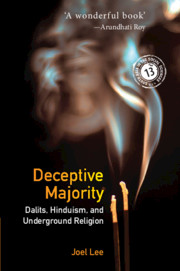1 - Introduction: Signs, the Census, and the Sanitation Labor Castes
Published online by Cambridge University Press: 15 February 2021
Summary
The census of India is a vast undertaking. Once a decade, every person residing in India—roughly one-sixth of humanity—is to be counted, named, and known. In 2011, I found myself in the midst of this monumental endeavor.
The scene was Lucknow, famed for its kabobs and culture of politesse yet also the capital of the north Indian state of Uttar Pradesh (or “UP,” as it is called), known for its rancorous caste and communal politics. I had not anticipated being present for the decennial census—its fifteenth iteration since the inaugural British attempt in 1871–72—but I arrived in Lucknow, by chance, on the second day of its implementation. Though observing such a state exercise had not figured in my research design, the potential value it held for an ethnographic study was undeniable, and within a few days I began accompanying census workers on their rounds.
My companions were surveying a Dalit neighborhood along a railway track when I began to sense that foundational premises about caste and religious belonging were misplaced. The words with which the enumerators filled their forms told one story, but the silences and circumlocutions of the enumerated seemed to hint at something else.
I wanted to understand Dalit religion. I sought, that is, to learn from those who suffer the structural violence of untouchability how their experience of stigma shapes their sense of religious belonging. My interests lay particularly with the caste cluster that supplies virtually all of South Asia's sanitation workers. Today the sanitation labor castes are widely regarded as simply and self-evidently Hindu. In swaths of north India, indeed, they have a reputation for displays of Hindu zealotry and support for Hindu majoritarianism. Yet little more than a century ago none of this was the case. The sanitation labor castes were known then for defying, in more ways and to a greater extent than other groups, categorization under the religious taxonomy of the colonial state. Far from appearing as straightforwardly Hindu, they featured in the reports of the decennial censuses as a secretive, “chameleon-like” community whose company Hindus abhorred, a community whose syncretic religious observances generated “a great deal of confusion,” making them “the chief disturbing element” in the mapping of India's religions (Rose 1902: 113).
- Type
- Chapter
- Information
- Deceptive MajorityDalits, Hinduism, and Underground Religion, pp. 3 - 30Publisher: Cambridge University PressPrint publication year: 2021



